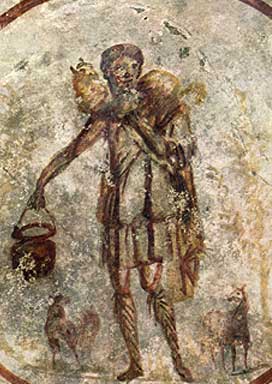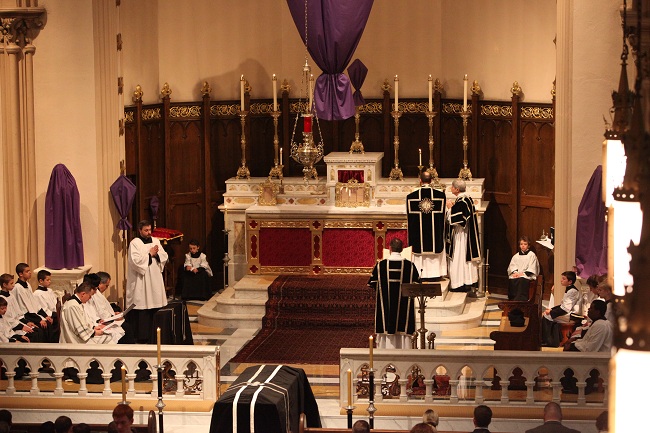This will be the fourth and final installment on the obscure patristic text The Shepherd of Hermas, which follows a series of mystical visions about the end times and the nature of the Church given to Hermas, a freed Roman slave and brother of Pope St. Pius I. These parables are, to say the least, esoteric and abstract, which, along with the failed end times prediction, probably impeded its entry into the the canon of Scripture. This work still makes for great spiritual reading and need not be read sequentially. As a Lenten exercise, I would recommend spending some time with the first book of the Shepherd. We resume with the four final parables:
In the seventh parable the angelic shepherd explains to Hermas why he must suffer on account of the sins of his family, their loss of faith or presumed apostasy in a period of persecution. It is fitting, the angel says, for the head of the house to suffer for the sins of its inhabitants, to render satisfaction for the ills of the whole. Our modern ears hear offence at the idea of justice issued communally, but in these times entire peoples suffered for the sins of a few or many of them, if not for aiding those sins then for not condemning them. "The person who repents," the angel teaches, "must torture his own soul, and must be thoroughly humble in his every action.... and if he endures the afflictions which come upon him, then assuredly He Who created all things and endowed them with power will be moved with compassion and will bestow some remedy."
The eighth is the parable of the willow tree. Hermas watches the shepherd lop off many branches of an enormous tree and, amazed that the tree can survive such extensive pruning, watches the angel distribute them. Some remain green, some whither, some are eaten by moths, but a few grow shoots and even fruit. The angel sends the holders of these branches to the tower that represents the Church. Hermas, still confused, asks for an explanation. The angel unravels the mystery. The tree that can survive indefinite pruning is the Law of the Son of God, which provides shade to His people, who are protected by the archangel Michael. This Law many ignore, many abuse, but many accept and even allow to flourish within them. These last men are the ones with the fortuitous branches. Some of the withered and cracked branches repair, overcoming Hermas and the shepherd with joy, but others remain broken, just as some sinners repent and bring joy unto God in doing so while others betray the Church in their sins and apostasy. Among those who keep the laws of God and repent there "is no place for rivalry" as to who is the greatest, for all should be happy to be within the tower that is the Church. The latter group, those who live partially in the world and partially in the Church, those with the somewhat withered branches, may be either saved or lost depending on their will move into one camp or another, to claim the fruit of their deeds.
The angel leads Hermas to a plain between twelve hills—some green, some brown, some burned, one lush, and one beautiful. On a mountain adjoining the plain virgins build a familiar great white tower, beginning with six stones, then ten, then twenty-five, and so on. Virgins, those weak and naive to the world, are the strong builders and pillars of the Church and of heaven in the eyes of "the Master," who comes to inspect the tower and finds some of the stones cracked and wanting. He discards of them as He discards of those who leave the Church and invites new stones in their places. Some of these new stones are not cuts, still round. These rest on the sides of the tower and are not forced into slots just yet.
Hermas and the angel inspect the tower and complete its surroundings with plaster, seal it, and clean the detritus. The angel then departs Hermas, who is perplexed that he is being left alone in the event the Master returns. The angel returns at morning after Hermas and the virgins spend the night in prayer. Why, Hermas inquires, is there a gate and a rock at the tower? The rock, the shepherd explains, is the Son of God, anciently predating the Creation of the Father and hence an "adviser" in the Creation by the Father. The gate, however, is not new, but only known now in the last stages and the consummation of the world. "No one shall enter the kingdom of God," the angel concludes, "unless he accept the name of the Son of God." The kingdom of the God is a city like those which existed at the time of Hermas and today exist only for tourists: walled all around, with the exception that the kingdom of God has but one gate. The stones cast away were those unworthy of entering through the gate because they held not the name of the Son of God—the shepherd never says "Jesus" or any linguistic variation of "Christ." The Son of God, the rock upon which the tower is built, "sustains the world" which rests upon Him, echoing the phrase "the stone the builders have rejected has become the cornerstone." Some stones cracked and turned black because they are like unto those who know God and sin against Him, a greater offence than not knowing God and sinning against natural reason. Again, the angel pastor admonishes Hermas to repent and forfeit guile, grudges, and urges to sow seeds of disunion within the Church.
Then follows the last of the parables and the end of the work. The shepherd and another angel visit Hermas after writing the preceding work and remind him that God has power over repentance. They know Hermas is not about to live a life of full repentance immediately, but that he wants to do so and to follow the commandments of God. As an enduring test, they leave the virgins from the tower with Hermas. If he follows God in purity, they will remain in his abode. If he deviates, they will leave. How the soul and grace are the same!
The angel leads Hermas to a plain between twelve hills—some green, some brown, some burned, one lush, and one beautiful. On a mountain adjoining the plain virgins build a familiar great white tower, beginning with six stones, then ten, then twenty-five, and so on. Virgins, those weak and naive to the world, are the strong builders and pillars of the Church and of heaven in the eyes of "the Master," who comes to inspect the tower and finds some of the stones cracked and wanting. He discards of them as He discards of those who leave the Church and invites new stones in their places. Some of these new stones are not cuts, still round. These rest on the sides of the tower and are not forced into slots just yet.
Hermas and the angel inspect the tower and complete its surroundings with plaster, seal it, and clean the detritus. The angel then departs Hermas, who is perplexed that he is being left alone in the event the Master returns. The angel returns at morning after Hermas and the virgins spend the night in prayer. Why, Hermas inquires, is there a gate and a rock at the tower? The rock, the shepherd explains, is the Son of God, anciently predating the Creation of the Father and hence an "adviser" in the Creation by the Father. The gate, however, is not new, but only known now in the last stages and the consummation of the world. "No one shall enter the kingdom of God," the angel concludes, "unless he accept the name of the Son of God." The kingdom of the God is a city like those which existed at the time of Hermas and today exist only for tourists: walled all around, with the exception that the kingdom of God has but one gate. The stones cast away were those unworthy of entering through the gate because they held not the name of the Son of God—the shepherd never says "Jesus" or any linguistic variation of "Christ." The Son of God, the rock upon which the tower is built, "sustains the world" which rests upon Him, echoing the phrase "the stone the builders have rejected has become the cornerstone." Some stones cracked and turned black because they are like unto those who know God and sin against Him, a greater offence than not knowing God and sinning against natural reason. Again, the angel pastor admonishes Hermas to repent and forfeit guile, grudges, and urges to sow seeds of disunion within the Church.
Then follows the last of the parables and the end of the work. The shepherd and another angel visit Hermas after writing the preceding work and remind him that God has power over repentance. They know Hermas is not about to live a life of full repentance immediately, but that he wants to do so and to follow the commandments of God. As an enduring test, they leave the virgins from the tower with Hermas. If he follows God in purity, they will remain in his abode. If he deviates, they will leave. How the soul and grace are the same!















